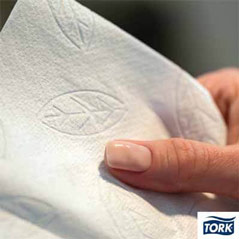
Lately, there has been talk about the importance of hand hygiene. For years the scientific community has been dealing with the issue of hand hygiene and their cleanliness has been the subject of studies and research.
However, when we hear "hand hygiene" our mind goes mainly to the process of washing them. Here we come to add and highlight an often overlooked process: hand drying. As important as hand washing is, so is their drying, since one process complements the other and is inextricably linked.
But what is the appropriate way to dry your hands?
The above question has been the subject of much research [1], the results of which show that:
- The air appliances, as the wet hands dry, disperse bacteria, viruses and other harmful microorganisms into the space. Thus, there is a risk for the people standing in front of them to come in contact with them, inhale them or settle on their clothes. In a study of 2015[2] Hot air appliances were found to disperse 1300 times more bacteria than paper towels.
- In a study published in Journal of Hospital Infection[3], It is reported that the total bacterial levels in the hot air appliances were up to 30 times higher compared to the bacteria that may be present in the hand towel appliances..
- Hand dryers, in addition to dispersion, can facilitate the growth of germs because they provide a warm and humid environment, ideal for their incubation.
- Study of Westminster University[4] concluded that disposable wipes not only promote the least spread of germs, but also effectively remove the remaining bacteria left on the hands after washing.
- The paper towel not only dries the hands more efficiently, but also faster. Specifically a hand towel dries the hands by 96% in 10 seconds while air appliances need 45 seconds to achieve similar results (97%).
- Another interesting and practical aspect of air appliances is that they allow only one user at a time to use them and this person may even need a minute to dry his hands. So many to avoid waiting choose to dry their hands a little to not at all.
- Air appliances can be quite noisy. The volume levels even reach 90 decibels. This sound is just as loud as that of a lawn mower.
- Hand towels can be used multiple times after hand washing to close the tap or open the door.
Συμπερασματικά
The results of the relevant studies show that from the point of view of hygiene, the drying of the hands with a disposable paper towel is superior to the drying of the hands with air.Strong objections and concerns regarding the excessive use of paper have been expressed for environmental reasons. In this, the stationery industry comes to respond with disposable paper companies να use innovative strategies to ensure that their products are produced with environmentally friendly practices, such as τthe maintenance of forestry, τονreduction of CO2 emissions and τη use of appropriate recycling measures. In fact, more and more paper products are soluble and biodegradable. Hand towels can be a viable and environmentally friendly option for hand drying. Towels are now set up to provide guests with enough paper to dry their hands completely each time.
No matter where it comes from, hospitals, restaurants, retail stores, schools or other high-traffic facilities, hand towels are a critical factor in good hand hygiene.
Consumers themselves clearly show their preference. It is no coincidence that 75% of people prefer paper towels to hot air dryers. Providing towels in shared toilets, their guests are given the ideal and desired method of drying hands, while ensuring the environment is cleaner, safer and healthier.
[1] Mayo clinic, The Hygienic Efficacy of Different Hand-Drying Methods: A Review of the Evidence https://www.mayoclinicproceedings.org/article/S0025-6196(12)00393-X/abstract
[2] Society for applied microbiology, https://sfamjournals.onlinelibrary.wiley.com/doi/full/10.1111/jam.13014
[3] The journal of hospital infection, https://www.journalofhospitalinfection.com/article/S0195-6701(18)30366-9/abstract
[4] https://europeantissue.com/hygiene/studies/uow/

Food Contact Materials
Foods come into contact with a variety of materials and objects during their production, processing, storage, preparation and supply and before their final consumption. These materials are called Food Contact Materials (FCM). Such materials include glass, plastic and paper.
Paper in particular, is the second in use Food Contact material after plastic. Contamination or other adverse health effects that may result from exposure of food to hazardous substances on paper are of great concern.[1].
Η Director-General of the European Consumer Agency (BEUC European Consumer Organisation), Monique Goyens, stated that consumers mistakenly assume that materials that come in direct contact with their food, are free of harmful substances. The reality is different. In a survey conducted for their safetyFood Contact found that while the materials in question alone could not endanger human health, the accumulation of these materials contributes to the overall exposure of the consumer to potentially harmful chemicals..[2]
The ingredients of Food Contact materials must not affect the health of consumers and the quality of food[3].
The relevant legislation stipulates that the materials that come in contact with food, must be inert and not adversely affect them by contaminating them with substances that are transferred from them to food.
The European Union and the E.F.E.T. have issued instructions onFood Contact materials. The purpose of these guidelines is to inform and protect consumers, who should pay attention to both the labeling of the products and how they handle them so that they can use them safely. [4].
That is why informed consumers, before buying kitchen paper, should check for the presence of a food contact mark which can be indicated either by the phrase "for food contact" or by the symbol:
![]()
[1] https://www.sciencedirect.com/science/article/abs/pii/S0273230016301830
[2] The Parliament Magazine - Paper food packaging "not as innocent as it seems", says consumer body - 2019-07-30
[3] Eiropean Union, cs_fcm_legis_pm-guidance_brochure_ella

The skin is the largest organ of the human body. It differs from person to person but its role is common to all and very important. It offers protection to the human body, regulates the temperature of the human body, helps breathing. That's why it deserves the best care and protection.
In some areas of our body, our skin is by nature more sensitive. In this context, it is often advisable by health professionals to use products labeled "Dermatologically tested" or "Hypoallergenic".
"Dermatologically tested product" means that specialized dermatologists have tested how the skin reacts when it comes in contact with a product. "Hypoallergenic" is the product that minimizes the risk of an allergy.
That is why the production of stationery products has been enriched with innovative products that best support consumers and meet the needs of their skin.
In case of sensitivity or allergies to specific ingredients, the use of toilet paper, which is dermatologically tested and hypoallergenic, becomes mandatory. Otherwise, dryness, pain, redness, rash and other annoying symptoms may occur.
Common toilet paper consists of ingredients that are not hypoallergenic. These ingredients can often trigger the onset of an allergy. On the other hand, toilet paper that has been tested for hypoallergenicity does not pose a risk of allergies.
Using cheaper or less reliable products can often lead to skin irritation and discomfort, which will be at least unpleasant and very uncomfortable.
Specialized series of paper that are hypoallergenic and / or dermatologically tested, with a normal pH that respects the skin and sensitive areas of the body are produced by certified companies. To ensure the hygiene of consumers, they are advised to look for, prefer and supply products that bear the relevant label.
![]()
Almost all drinking water contains salts. With the heating of the water, the salts decompose and through the water vapors settle on the surfaces of the bathroom or the kitchen. The problem with common detergents - apart from their controversial effectiveness - is the wear they cause on surfaces but also the strong odor they produce due to strong - as well as often dangerous - acids they contain. With the sanitary cleaning products we ensure the safe cleaning of the areas from salts and in combination with their bacteriostatic properties it neutralizes the action of most microbes and microorganisms.

One of the most difficult stains is the ink of any type on her clothes and fabrics. The SC 10 Dr Schnell cleaning solution puts an end to any problems that may arise create us a marker, pen, etc. Test the color fastness of your fabric and get rid of inks on your clothes.





